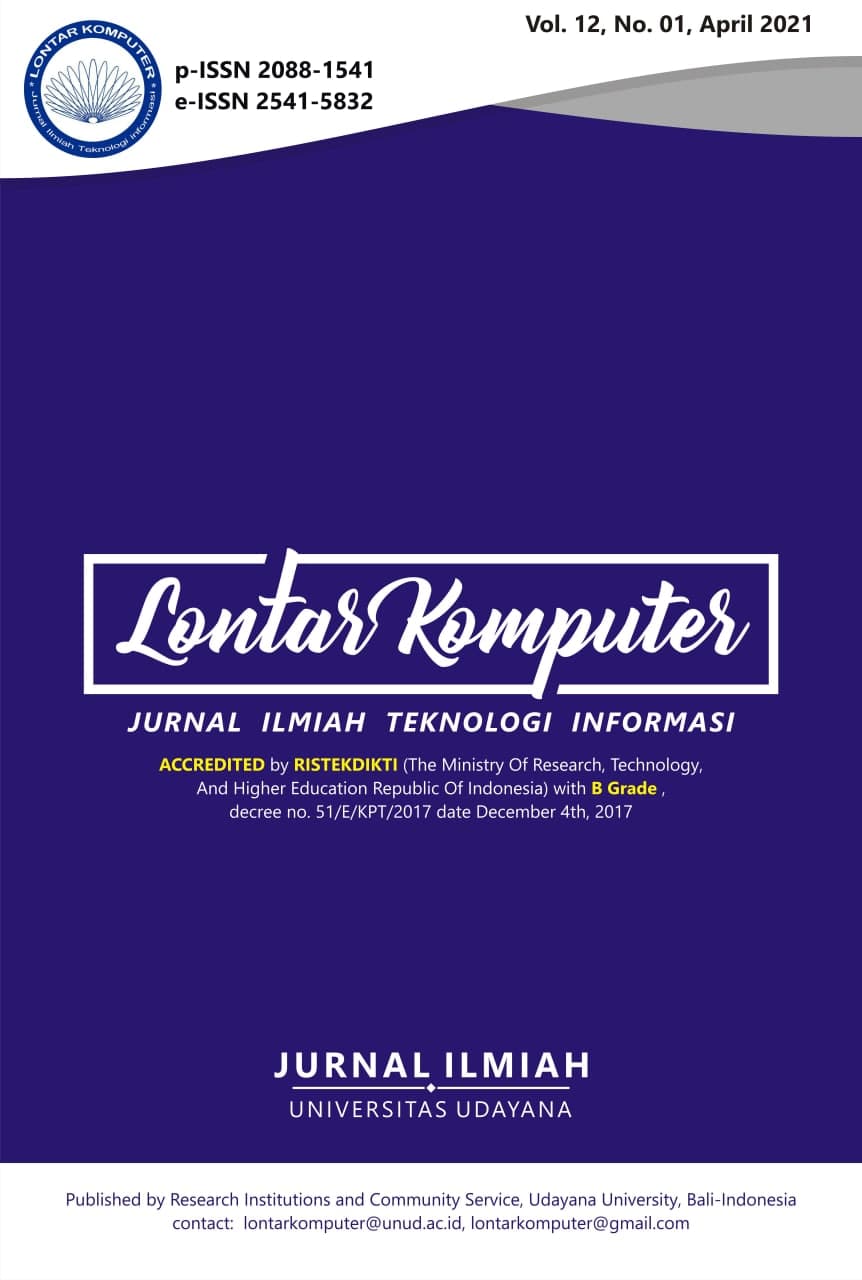Frequency Band and PCA Feature Comparison for EEG Signal Classification
Abstract
The frequency band method is popular in signal processing; this method separates EEG signals into five bands of frequency. Besides the frequency band, the recent research show PCA method gives a good result to classify digits number from EEG signal. Even PCA give a good accuracy to classify digit number from EEG signal, but there are no research shows which one yielded better accuracy between PCA and frequency band to classify digit number from EEG signals. This paper presents the comparison between those methods using secondary data from MindBigData (MDB). The result shows that the frequency band and PCA achieve 9% and 12,5% on average accuracy with the EPOC dataset. The paired Wilcoxon test produces a significant difference in accuracy between methods in the digit classification problem. Experiment with Muse dataset provides 31% accuracy with frequency band method and 24,8% with PCA method. The result is competitive compared to other experiments to classify digit numbers from EEG signals. In conclusion, there is no winner between the two methods since no method fits both datasets used in this research.
Downloads
References
[2] Jordan J. Bird, Diego R. Faria, Luis J. Manso, Anikó Ekárt, Christopher D. Buckingham "A Deep Evolutionary Approach to Bioinspired Classifier Optimisation for Brain-Machine Interaction", Complexity, vol. 2019, ArticleID 4316548, 14 pages, 2019. https://doi.org/10.1155/2019/4316548
[3] N. Kasabov, "Springer Handbook of bio-/neuroinformatics," Springer Handb. Bio-/Neuroinformatics, no. June 2016, pp. 1–1229, 2014. DOI 10.1007/978-3-642-30574-0
[4] Kögel J, Schmid JR, Jox RJ, Friedrich O. "Using brain-computer interfaces: a scoping review of studies employing social research methods". BMC Med Ethics. 2019 Mar 7;20(1):18. doi: 10.1186/s12910-019-0354-1
[5] S. D. Rosca and M. Leba, "Using brain-computer-interface for robot arm control" MATEC Web Conf., vol. 121, article number 08006, 7 pages, 2017. DOI: 10.1051/matecconf/20171210 MSE 2017 8006
[6] Chen D, Yang W, Miao R, Huang L, Zhang L, Deng C, Han N. Novel joint algorithm based on EEG in complex scenarios. Comput Assist Surg (Abingdon). 2019 Oct;24(sup2):117-125. doi: 10.1080/24699322.2019.
[7] B. L. K. Jolly, P. Aggrawal, S. S. Nath, V. Gupta, M. S. Grover, and R. R. Shah, "Universal EEG Encoder for Learning Diverse Intelligent Tasks," 2019 IEEE Fifth International Conference on Multimedia Big Data (BigMM), Singapore, 2019, pp. 213-218, doi: 10.1109/BigMM.2019.00-23.
[8] A. Ameera, A. Saidatul, and Z. Ibrahim, "Analysis of EEG Spectrum Bands Using Power Spectral Density for Pleasure and Displeasure State" IOP Conference Series: Materials Science Engineering, vol. 557, no. 1, 2019. https://doi.org/10.1088/1757-899X/557/1/012030
[9] A. Morley, L. Hill, and A. G. Kaditis, "10-20 System EEG Placement" Eur. Respir. Soc., p. 34, 2016. [Online]. Available: https://www.sleep.pitt.edu/wp-content/uploads/2020/03/10-20-system-el.pdf. [Accessed: 10-Dec-2020].
[10] P. Campisi, D. La Rocca and G. Scarano, "EEG for Automatic Person Recognition," in Computer, vol. 45, no. 7, pp. 87-89, July 2012. DOI: 10.1109/MC.2012.233.
[11] D. Vivancos, "MindBigData The 'MNIST' of Brain Digits," 2018. [Online]. Available: http://www.mindbigdata.com/opendb/. [Accessed: 10-Dec-2021].
[12] J. Jeong, "The Most Intuitive and Easiest Guide for Convolutional Neural Network" 2019. [Online]. Available: https://towardsdatascience.com/the-most-intuitive-and-easiest-guide-for-convolutional-neural-network-3607be47480. [Accessed: 21-Jan-2021].
[13] D. A. Nasution, H. H. Khotimah, and N. Chamidah, “Perbandingan Normalisasi Data untuk Klasifikasi Wine Menggunakan Algoritma K-NN”, Journal of Computer Engineering, System and Science, vol. 4, no. 1, p. 78, 2019. DOI: https://doi.org/10.24114/cess.v4i1.11458
[14] S. Siuly, Y. Li, and Y. Zhang. EEG Signal Analysis and Classification Techniques and Application, Edition 1. Springer International Publishing. 2016. pp. 3-13. DOI : 10.1007/978-3-319-47653-7
[15] H. Hindarto and S. Sumarno, "Feature Extraction of Electroencephalography Signals Using Fast Fourier Transform" CommIT (Communication and Information Technology) Journal, vol. 10, no. 2, p. 49, 2016. doi : https://doi.org/10.21512/commit.v10i2.1548
[16] P. A. Abhang, B. W. Gawali, and S. C. Mehrotra. Introduction to EEG- and Speech-Based Emotion Recognition. Academic Press, 2016, pp. 19–50. https://doi.org/10.1016/B978-0-12-804490-2.00002-6
[17] Forrest Sheng Bao, Xin Liu, Christina Zhang, "PyEEG: An Open Source Python Module for EEG/MEG Feature Extraction", Computational Intelligence and Neuroscience, vol. 2011, ArticleID 406391, 7 pages, 2011. https://doi.org/10.1155/2011/406391
[18] S. Mishra, S. Taraphder, U. Sarkar, and S. Datta, "Principal Component Analysis," vol. 7, no. 5, pp. 60–70, 2017. DOI: 10.5455/ijlr.20170415115235
[19] Tharwat, Alaa. (2016). Principal component analysis - a tutorial. International Journal of Applied Pattern Recognition. 3. 197. 10.1504/IJAPR.2016.079733.
[20] J. A. López del Val and J. P. Alonso Pérez de Agreda, “Principal components analysis,” Aten. Primaria, vol. 12, no. 6, pp. 333–338, 1993.
[21] V. Powell and L. Lehe, "Principal Component Analysis.", 2015. [Online]. Available: https://setosa.io/ev/principal-component-analysis/. [Accessed: 20-Jan-2021]
[22] A. Bablani, D. R. Edla, and S. Dodia, "Classification of EEG data using k-nearest neighbor approach for concealed information test". Procedia Computer Science, vol. 143, pp. 242–249, 2018. https://doi.org/10.1016/j.procs.2018.10.392
[23] Y. Jung and J. Hu, "A K-fold averaging cross-validation procedure" J. Nonparametr. Stat., vol. 27, no. 2, pp. 167–179, 2015. doi: 10.1080/10485252.2015.1010532
The Authors submitting a manuscript do so on the understanding that if accepted for publication, the copyright of the article shall be assigned to Jurnal Lontar Komputer as the publisher of the journal. Copyright encompasses exclusive rights to reproduce and deliver the article in all forms and media, as well as translations. The reproduction of any part of this journal (printed or online) will be allowed only with written permission from Jurnal Lontar Komputer. The Editorial Board of Jurnal Lontar Komputer makes every effort to ensure that no wrong or misleading data, opinions, or statements be published in the journal.
 This work is licensed under a Creative Commons Attribution 4.0 International License.
This work is licensed under a Creative Commons Attribution 4.0 International License.























